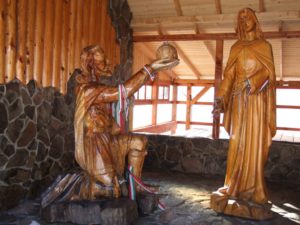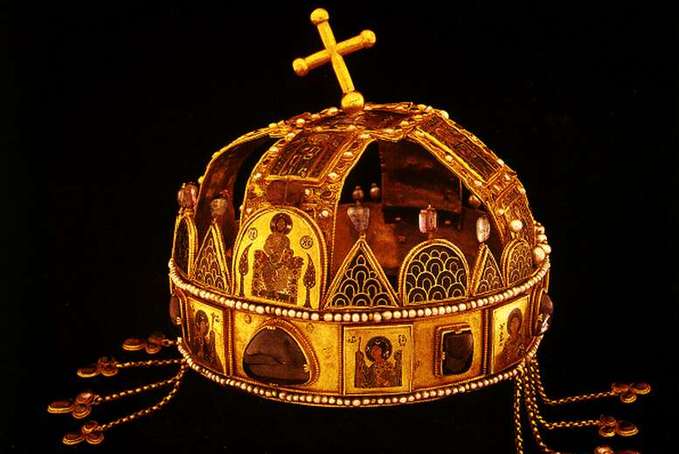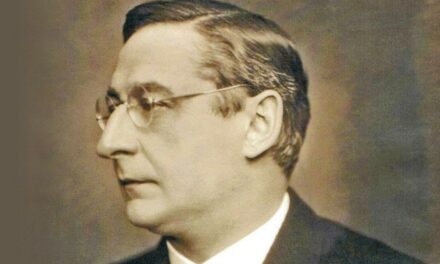We cannot forget the people of the Regnum Marianum, who were not much concerned with the legal aspects, since the serfdom had no rights in the management of the state of order.
The religious folk soul, with its lower childish education and specific worldview, experienced a specific Marian experience, the world of ideas of the Marian country. This worldview was strengthened by the tragic loss of Turkish destruction and the fear of death caused by epidemics.
"The importance of places of farewell...from the point of view of Regnum Marianum is also manifested in raising the national self-awareness of the people. The conviction became general that there is no other country on earth where Mary has shown her miraculous power as many times and in so many places as our country. ” Believers also visit the "Hungarian" Mary from abroad. The miraculous Mária of Sümegi performed the first miracle at the begging of a woman from Vienna. (Sasvár, Sümeg, Boldogasszony, Máriavölgy were the known Marian places.)
Sándor Bálint , an excellent scholar of sacred ethnography, we can also infer the ancient roots of folk religiosity: "The Emese symbol (here we can add: the miraculous deer symbol, the tree of life, etc.) makes us understand the cult of the Blessed Virgin, which is striking for Saint Stephen and the Árpád house, the recommending the country to his protection, as it were, the survival and sublimation of the pagan matriarchal worldview... This belief explains why the Christian descendants build a church over Árpád's grave and similarly found a monastery in honor of Mary in Szeren, the legendary scene of the first parliament." According to Sándor Bálint, "Happy Lady" is presumably the name of an ancient female deity, as Lajos Kálmány wrote it already in the last century. From this also follows the continuity of the cult of the Blessed Virgin stretching back into the past, its specifically Hungarian character.
We must regard the veneration of the Mother of God, the Blessed Virgin, and the Blessed Virgin as one of the hard-to-dispute facts of our ancient history. We are ancient, Scythian non-Christians, not simply pagans, but owners of a tradition that has merged into Christianity, coming from the "primordial revelation" that goes back to the difficult-to-decipher past.
St. Gellért , it is clear that the holy man directly advised that the Virgin Mary is called the "Boldogasszony" or "the great woman of this world" in Hungary . This is the use of folk tradition to accept the Virgin Mary.
Let's read Tibor Molnárfi's summary of Regnum Marianum in a few sentences:
"the Regnum Marianum in a few sentences
the idea of the holy crown and its offering by the holy crown to Our Lady (ideally including the fact that she accepted it) makes Hungary as a community part of the task that is the task of the Mother of God in the natural and (mainly) supernatural, providential life of humanity. This is the destiny of our people. Our fate and all our specific historical tasks (all our conflicts over the centuries) are connected to this. This is why the shocked respect of the highest forums of moral life, the often mindless, burning and unjustified hatred of certain intellectual currents and historical movements, the harmful, harmful and painful destructive efforts of people on a daily basis are directed towards us. But our invincibility and immortality, despite our breakdowns, sacrifices and defeats, is connected to this. There is no doubt that the "metaphysical view of history" is not common in our modern world. But nevertheless it is effective and true.”

Gyimesbükk - Saint István offers the crown to the Virgin Mary (Source: Fókusz.info)
of József Mindszenty c. he writes in his book: "Hungarians, as a nation, met Mary throughout history through the offer of the country by Saint Stephen... it was indelibly engraved in the Hungarian public consciousness that Hungary is the country of Mary. This relationship is not an empty word, not an insignificant fantasy". And he summarizes the essence as follows: "The specifically Hungarian Regnum Marianum idea means that Mary protects her country, and we faithfully follow the Christian faith and enforce the teaching of the Gospel in our state and social life." In this regard, he saw our historical fate in this way: "I perceived the offer of the holy king as a supernatural factor affecting our history... The idea of Mary's country was like a key in my hand to unravel the ups and downs of Hungarian history, national greatness and national tragedies".
Gyula Szekfű evokes a similar idealism - appreciatively, placed in a historical context, about the religious and patriotic world view of the Baroque era and the Jesuit educational practice - when he wrote about the idea of Regnum Marianum: "Even at the founding of the apostolic kingdom of Mary, the Regnum Mariano-Apostolicum, divine grace was at work to a greater extent than in other European states. God is the protector of other Christian states, but he is also the founder and conditora of Hungary. Therefore, from the beginning, Hungary is not a simple secular, profane state, but a sacrosancta respublica, the foundation of which consists of two religious moments: one is the sending of the Holy Crown from Pope Sylvester, the other is the offering of the Crown to... the Virgin Mary."
The described Idea takes shape in books, paintings, statues, churches, their altarpieces, etc. We find it there in thousands of Hungarian churches, in the name of the church, in the image of the main and side altars. It is well known that Mary should only be depicted with a general crown. The only exception to this is the representation with the Hungarian Holy Crown. The Virgin Mary depicted with the Hungarian Holy Crown is not only the adornment of our country's churches, but is also there in Rome, in the sub-church a few meters from St. Peter's tomb. She can be found in Jerusalem, Nazareth, etc., as well as in Csíksomlyo as Babba Mária, as the "Beautiful Virgin Mary" of our litany - She is there in the legends, folk tales, lifestyle, and folk songs of the Hungarian people. But it is also there in political, diplomatic and interstate relations.
"The Holy Crown theory links the membership of the Holy Crown to the peoples living in the territory of the Holy Crown, regardless of language, religion, race, or nationality. Even today, a member of the Holy Crown is (can be) the one who recognizes the primacy of the Great Lady, who declares that he belongs to the Holy Crown: he is a part of it, whether Croatian, Slovak, Romanian, etc. In this way, the validity of the universal idea of membership in the Holy Crown is the foundation of equality between peoples, and it also proclaims the unity of the human race. This unity can therefore be manifested in a single state, but it can also be the membership of the Holy Crown of separately organized parts, as was the case for Croatia and Hungary for eight hundred years. If the development of history puts the unity of the autonomies on the agenda, then the "Hungarian" vocation of the members of the Holy Crown will be "the vocation of the people of the Blessed Virgin", as it was during the "Hungarian" membership, which was used as a political term. They too, as the chosen ones of Providence, fulfill the plan of Providence, which the director of world history designates as a member of the Holy Crown until the end of the world.












